Artillery in Canada: German First World War Artillery - historic photos of the guns captured by Canadians
German First World War Artillery captured by Canadians
Photos from the Library and Archives Canada collection.

(Library and Archives Canada Photo, MIKAN No. 3636763)
Painting of Canadians capturing a German First World War 7.7-cm Feldkanone 96 neuer Art (7.7-cm FK 96 n.A.), entitled "Taking the Guns", ca 1918, by Forunino Matania.

(Library and Archives Canada Photo, MIKAN No. 3397896)
German First World War 7.7-cm Feldkanone 96 neuer Art (7.7-cm FK 96 n.A.) captured by Canadians near Amiens, France, Aug 1918. This gun was known as the "Whiz Bang".

German 7.7-cm Feldkanone 96 n.A. with crew.

(Library and Archives Canada Photo, MIKAN No. 3397939)
Damaged German 7.7-cm Feldkanone 96 n.A. near Buissy. Captured during the advance East of Arras, September, 1918.

(Library and Archives Canada Photo, MIKAN No. 3194730)
17th Battery RCA firing a captured German 10.5-cm leFH 98/09 Howitzer on retreating German forces at Vimy Ridge, April 1917.

(Library and Archives Canada Photo, MIKAN No. 3397957)
German First World War 21-cm Mörser howitzer captured by Canadians during the advance East of Arras, October, 1918.

German First World War 21-cm Mörser howitzer being examined by a Canadian Officer, Arras, Aug 1918. CANADA scratched on the barrel.
The forces on opposite sides of the First World War learned to use artillery in massive concentrations of fire power. The carnage caused by the massive destructive power of the guns on all fronts helped lead to the stalemate of trench warfare. To try and overcome this, three techniques were developed to try and break the opposition. The French used a system known as rafale (gale wind) which involved a heavy bombardment of shells on enemy forces. Although there were terrible losses, the shells did not completely destroy enemy defences including barbed wire. The shell holes created additional obstaclesthat made movement even more difficult, with the end result that attacks did not succeed.
The barrage system was developed to make use of the increasing sophistication and availability of high explosive shells. Although it stil caused tremendous casualties, improved defence positions negated the effects of the bombardments, and attacks again failed to gain significant ground. The creeping barrage was developed to bombard the ground just ahead of the infantry, with the barrage being lifted and moved forward as the troops advanced. The enemy lines did not break.
The method of massing large numbers of guns firing a combination of gas and artillery shells was implemented to break enemy morale. This technique of firepower employment actually had a measure of success.

(Library and Archives Canada Photo, MIKAN No. 3397965)
German 7.7-cm FK16 and other guns captured by Canadians following the advance on Cambrai, November 1918.

(Library and Archives Canada Photo, MIKAN No. 3397889)
French de Bange 155-mm long cannon mle. 1877 (155 L de Bange) field gun, used by the Germans and captured by Canadians at thge Battle of Amiens, Aug 1918.

(Library and Archives Canada Photo, MIKAN No. 3397926)
German First World War artillery captured East of Arras, Aug 1918.

(Library and Archives Canada Photo, MIKAN No. 3397927)
German First World War artillery captured East of Arras, Aug 1918. (Library and Archives Canada Photo, MIKAN No. 3397927)

(Library and Archives Canada Photo, MIKAN No. 3397933)
German First World War artillery captured East of Arras, Aug 1918.

(Library and Archives Canada Photo, MIKAN No. 3397826)
German Lantz trench mortar captured by Canadians, May 1917.

(Library and Archives Canada Photo, MIKAN No. 3397938)
German First World War MG 08 machine-guns in a wagon towing a wheeled 7.58-cm leichtes Minenwerfer neuer Art, (7.58-cm leMW n.A.) trench mortar captured by Canadians during the advance east of Arras, France, Sep 1918.

(Library and Archives Canada Photo, MIKAN No. 3397956)
German First World War 7.58-cm leichtes Minenwerfer neuer Art, (7.58-cm leMW n.A.) wheeled trench mortar captured by Canadians during the advance East of Arras, October 1918.

(Library and Archives Canada Photo, MIKAN No. 3397823)
German 7.92-mm MG08s captured at Vimy Ridge, May 1917.

(Library and Archives Canada Photo, MIKAN No. 3403105)
German 7.92-mm MG08 assembly, May 1917.

(Library and Archives Canada Photo, MIKAN No. 3521829)
Captured German trench mortars being examined by Canadians, Apr 1917.

(Library and Archives Canada Photo, MIKAN No. 3194349)
German trench mortars captured by Canadians, Canal du Nord, Oct 1918. (Library and Archives Canada Photo, MIKAN No. 3194349)

(Library and Archives Canada Photo, MIKAN No. 3521845)
German 17-cm mittlerer Minenwerfers (17-cm mMW), captured by Canadians, Apr 1917.

(Library and Archives Canada Photo, MIKAN No. 3521871)
German trench mortars captured by Canadians, Apr 1917.
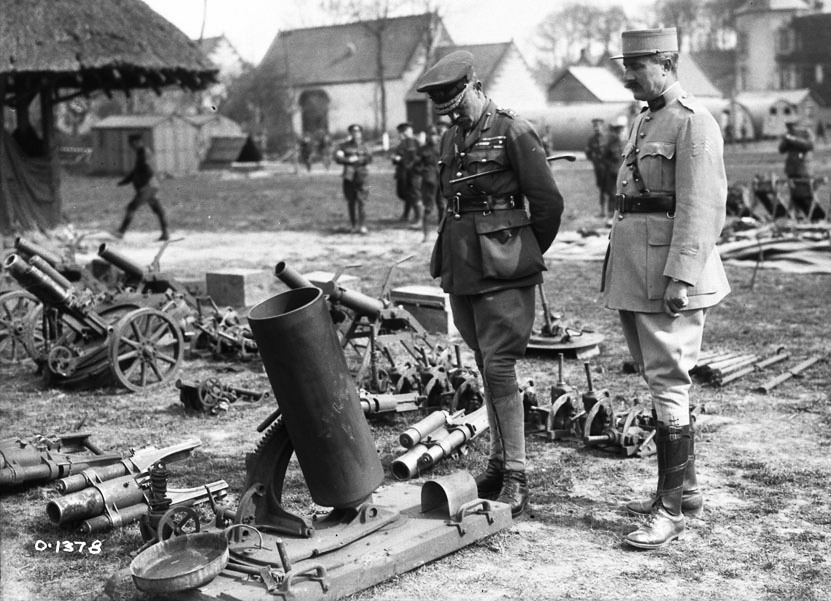
(Library and Archives Canada Photo, MIKAN No. 3213518)
German trench mortars captured by Canadians, May 1917, LGen Julian Bing.

(Library and Archives Canada Photo, MIKAN No. 3397962)
German trench mortars captured by Canadians, Oct 1918.
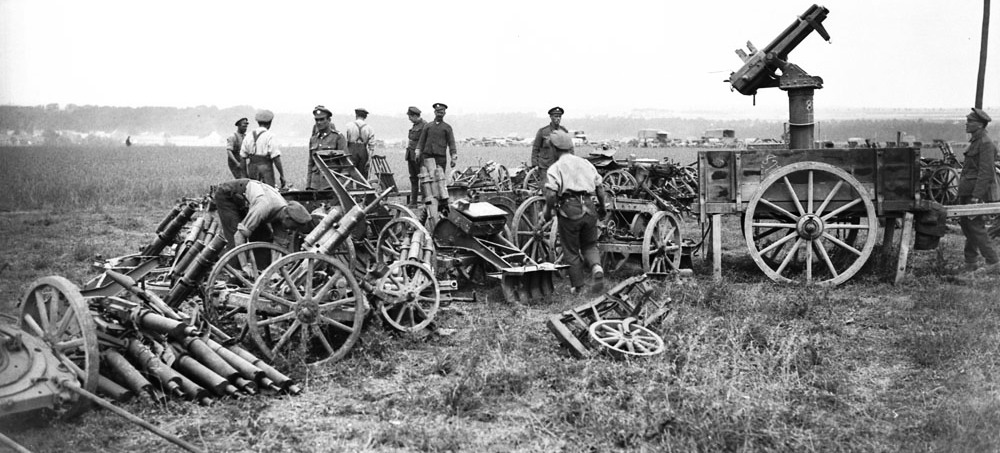
(Library and Archives Canada Photo, MIKAN No. 3397922)
Captured German trench mortars and AA Guns, Amiens, Aug 1918.

(Library and Archives Canada Photo, MIKAN No. 3397916)
Captured German AA Gun, Amiens, Aug 1918.

(Library and Archives Canada Photo, MIKAN No. 3403179)
Canadian soldier examining a German First World War 7.58-cm trench mortar as German prisoners carrying their wounded pass by him during the advance East of Arras, France, Aug 1918.

(Library and Archives Canada Photo, MIKAN No. 3397396)
Canadian and French soldiers with German ammunition wagon, Amiens, Aug 1918.

(Library and Archives Canada Photo, MIKAN No. 3397885)
German First World War 7.7-cm Feldkanone 96 neuer Art (7.7-cm FK 96 n.A.) captured by Canadians near Farbus, France, Feb 1918.

(Library & Archives Canada Photo, MIKAN No. 3396816)
French de Bange 155-mm long cannon mle. 1877 (155 L de Bange) field gun, Battle of Amiens, captured by the Germans and recaptured by the Canadians, Aug 1918.

(Library and Archives Canada Photo, MIKAN No. 3397890)
French de Bange 155-mm long cannon mle. 1877 (155 L de Bange) field gun, Battle of Amiens, captured by the Germans and recaptured by the Canadians, Aug 1918.

(Library and Archives Canada Photo, MIKAN No. 35222222)
French de Bange 155-mm long cannon mle. 1877 (155 L de Bange) field gun, Battle of Amiens, captured by the Germans and recaptured by the Canadians, Aug 1918.

(Library & Archives Canada Photo, MIKAN No. 3397889)
French de Bange 155-mm long cannon mle. 1877 (155 L de Bange) field gun, Battle of Amiens, captured by the Germans and recaptured by the Canadians, Aug 1918.

(Library and Archives Canada Photo, MIKAN No. 3397953)
German First World War 10.5-cm Feldhaubitze 98/09 (10.5-cm FH 98/09), captured by Canadians near Vis en Artois, France, Sep 1918.

(Library and Archives Canada Photo, MIKAN No. 3521875)
German 10.5-cm FH 98.09 Gun, captured by Cdns, 17th Bty, CFA, being used to fire on Germans, Apr 1917.

(Library and Archives Canada Photo, MIKAN No. 3522120)
German First World War 7.92-mm Maxim Spandau MG 08/15 machine-gun being examined by Canadian Motor Machine Gun Brigade Officers, March 1918.

(Library and Archives Canada Photo, MIKAN No. 3521832)
German First World War 15-cm schwere Feldhaubitze 13 (15-cm sFH 13) Heavy Field Howitzer, captured by Canadians, Farbus Village, France, Apr 1917.

(Library and Archives Canada Photo, MIKAN No. 3397894)
German l10-cm K 17 Field Gun captured at Amiens, France, Aug 1918.

(Library and Archives Canada Photo, MIKAN No. 3521837)
German First World War 8-inch Naval Gun captured at Farbus, France, Apr 1918.

(Library and Archives Canada Photo, MIKAN No. 3521833)
German Great War 8-inch Naval Gun, captured at Farbus, Apr 1918.

(Library and Archives Canada Photo, MIKAN No. 3397920)
Captured German 21-cm Morser gun and a 7.7-cm field gun being towed to a Gun Park, Amiens, Aug 1918.

(Library and Archives Canada Photo, MIKAN No. 3397937)
German 8.8-cm AA Gun, captured by Cdns East of Aras, Sep 1918.

(Library and Archives Canada Photo, MIKAN No. 3397921)
German 8.8-cm Flak 16 AA Gun examined by Canadians, Battle of Amiens, Aug 1918.

(Library and Archives Canada Photo, MIKAN No. 3397897)
Captured German 15-cm schwere Feldhaubitze 1902 (15-cm sFH 02) Heavy Field Howitzer, Amiens, Aug 1918.

(Library and Archives Canada Photo, MIKAN No. 3397887)
Captured German 15-cm schwere Feldhaubitze 1902 (15-cm sFH 02) Heavy Field Howitzer, Amiens, Aug 1918.


(Photos courtesy of Bridget, Ladysmith Historical Society)
German First World War 7.7-cm Feldkanone 16 (7.7-cm FK 16), possibly (Serial No.7065), on display from 1921 until removed in 1941 by rail, and sent to the smelter to aid in the war effort.

(Library and Archives Canada Photo, MIKAN No. 3397899)
German First World War 21-cm Mörser gun being examined by a Canadian Officer, Arras, Aug 1918. CANADA scratched on the barrel.

(Library and Archives Canada Photo, MIKAN No. 3397825)
German Great War 21cm Morser, captured by 13th Bn, Amiens, Aug 1918.

(Library and Archives Canada Photo, MIKAN No. 3397850)
German Great War 21cm Morser, captured by Canadians at Vimy Ridge, Aug 1917.

(Library and Archives Canada Photo, MIKAN No. 3397851)
German Great War 21cm Morser, captured by Canadians at Vimy Ridge, Aug 1917.

(Library and Archives Canada Photo, MIKAN No. 3397957)
German Great War 21cm Morser, captured by Canadians during the advance East of Arras, Oct 1918.
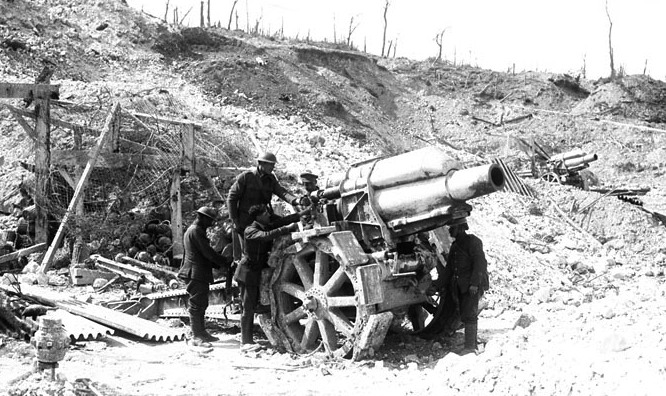
(Library and Archives Canada Photo, MIKAN No. 3397817)
German Great War 21cm Morsers captured by Canadians at Vimy Ridge, May 1917.

(Library and Archives Canada Photo, MIKAN No. 3397819)
German Great War 21cm Morsers captured by Canadians at Vimy Ridge, May 1917.

(Library and Archives Canada Photo, MIKAN No. 3397919)
General Currie inspecting captured German Great War 21-cm Morsers.

(Library and Archives Canada Photo, MIKAN No. 3397820)
German First World War 21-cm Mörser Heavy Mortar damaged by shellfire, being examined by a Canadian Officer, May 1917.

(Library and Archives Canada Photo, MIKAN No. 3406014)
Canadian troops with captured German Great War 21-cm Morser.

(Library and Archives Canada Photo, MIKAN No. 3397895)
Captured German Great War 21-cm Morser.
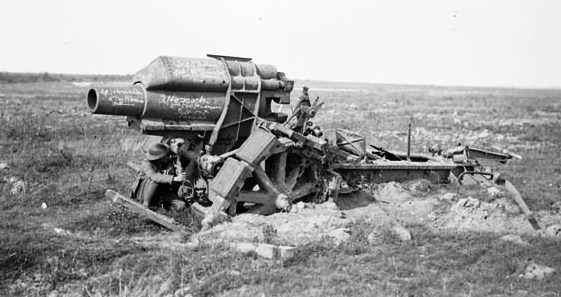
(Library and Archives Canada Photo, MIKAN No. 3395091)
German First World War 21-cm Mörser captured by Canadians, 1918.

(Library and Archives Canada Photo, MIKAN No. 3397923)
General Currie inspecting captured German Great War Naval Guns.
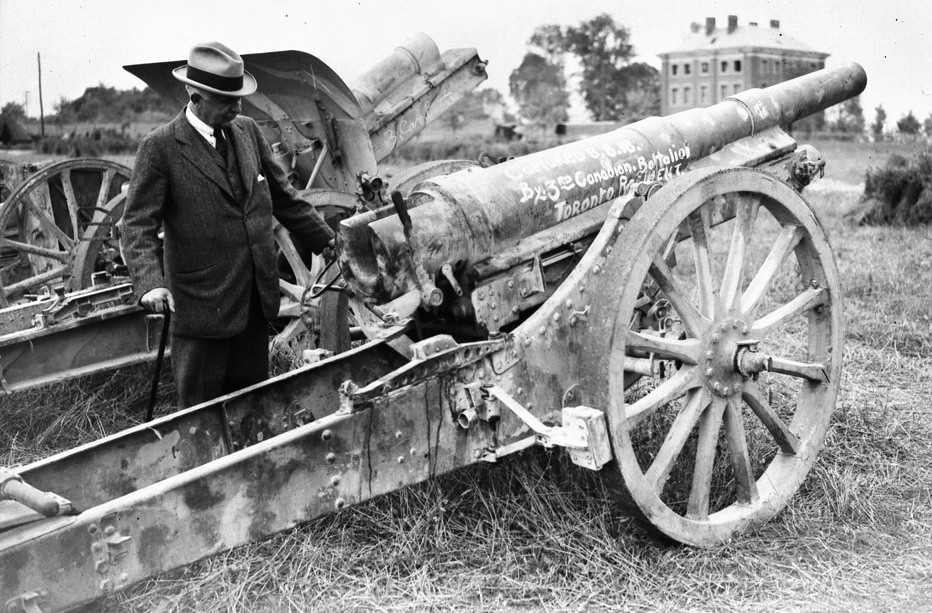
(Library and Archives Canada Photo, MIKAN No. 3397930)
German Naval Gun captured East of Arras, being examined by civilian VIPs, Aug 1918.

(Library and Archives Canada Photo, MIKAN No. 3397931)
German Naval Gun captured East of Arras, being examined by civilian VIPs, Aug 1918.

(Library and Archives Canada Photo, MIKAN No. 3397915)
General Currie inspecting captured German Great War Naval Guns close in.

(Library and Archives Canada Photo, MIKAN No. 3397914)
General Currie inspecting captured German First World War Naval Guns.

(Library and Archives Canada Photo, MIKAN No. 3397975)
Austrian Mountain Battery Gun captured by Canadians at Cambrai, France, Nov 1918.

(Library and Archives Canada Photo, MIKAN No. 3395388)
Canadian soldiers examining a German anti-tank rifle captured during the Battle of Amiens, France, in front of a British Male tank, August, 1918.





